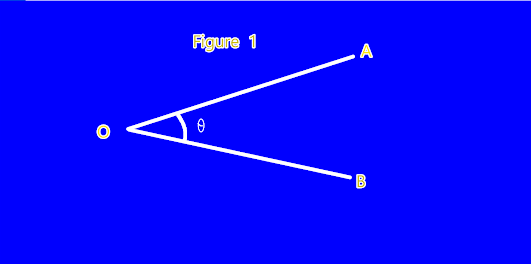प्रयोग संख्या-1
ओब्जेक्ट : क्षैतिज कोण को सामान्य विधि से मापना। उपकरण: स्टैंड के साथ थियोडोलाइट, छड़ें लेकर। वी
क्षैतिज कोण को मापने की सीधी या सामान्य विधि पर विचार करें
चित्र -1 ) मान लीजिए कि कोण AOB को मापा जाना है। निम्नलिखित
प्रक्रिया अपनाई जाती है।
प्रक्रिया:
1. उपकरण को 0 पर सेट करें।
(इसका मतलब है कि केंद्रीकरण और समतलन पूरी तरह से किया गया) बी
2. लंबवत सर्कल को बाईं स्थिति में रखें। चित्र 5.1
3. लोअर क्लैंप को रखकर फिक्स किया जाता है। ऊपरी क्लैंप ढीला है और द्वारा
दूरबीन को दक्षिणावर्त घुमाते हुए, वर्नियर A को 00 पर और वर्नियर B को लगभग 180° पर सेट किया जाता है।
4. ऊपरी क्लैंप को फिर कड़ा कर दिया जाता है। अब ऊपरी स्पर्शरेखा पेंच को मोड़कर, वर्नियर A और B को पर सेट किया जाता है
आवर्धक काँच से देखने पर ठीक 0° और 180°।
5. ऊपरी क्लैंप को स्थिर रखकर, निचले हिस्से को ढीला करें और दूरबीन को बाईं ओर की ओर निर्देशित किया जाता है। ई.ए.
6. दूरदर्शी को ठीक से फोकस करके और लंबन को हटाकर रेंजिंग रॉड A को लगभग द्विभाजित किया जाता है।
7. अब निचले क्लैंप को कड़ा कर दिया गया है और रेंज ए रॉड को सटीक रूप से द्विभाजित किया गया है।
8. निचले क्लैंप को स्थिर रखने से ऊपरी क्लैंप ढीला हो जाता है।
9. दूरदर्शी को दक्षिणावर्त घुमाया जाता है ताकि रेंजिंग रॉड को B पर ठीक से फोकस करके लगभग समद्विभाजित किया जा सके
दूरबीन। ऊपरी क्लैंप को कड़ा कर दिया जाता है और बी पर रेंजिंग रॉड को ऊपर की ओर घुमाकर सटीक रूप से द्विभाजित किया जाता है
स्पर्शरेखा पेंच।
वी
10. वर्नियर ए और बी पर रीडिंग नोट की जाती हैं।
11. वर्नियर ए सीधे रीडिंग देता है। लेकिन वर्नियर बी के मामले में, अंतिम रीडिंग से प्रारंभिक रीडिंग घटाकर कोण प्राप्त किया जाता है।
12. पाठ्यांकों को सारणी 1 में सारणीबद्ध रूप में नोट किया गया है।
13. उपकरण का चेहरा बदल दिया जाता है और उपरोक्त प्रक्रिया का पालन किया जाता है।
14. वर्नियर्स की रीडिंग तालिका में नोट की गई है।
15. प्रेक्षणों का माध्य (अर्थात बाएँ और दाएँ चेहरा) वास्तविक कोण <AOB है।
16. इन दो प्रेक्षणों को अपूर्ण समायोजन के कारण किसी भी संभावित त्रुटि को समाप्त करने के लिए लिया जाता है
आईआर.उपकरण
एहतियात: PRECAUTIONS
1. यदि आवश्यक हो, तो प्लेट के बुलबुले को देखने के बाद, पैर के शिकंजे का उपयोग करके केंद्रित किया जाना चाहिए, लेकिन पैर के शिकंजे को प्रारंभिक दृष्टि और अंतिम दृष्टि की रेखा के बीच स्पर्श नहीं किया जाना चाहिए।
2. दूरबीन के माध्यम से देखने से पहले रफ पॉइंटिंग के लिए दूरबीन पर राइफल की जगहों का उपयोग करें।
3. जब क्लैंप स्क्रू अभी भी ढीला हो, तो हाथ से उचित रूप से बंद सेटिंग करें, ताकि टेंगेंट स्क्रू को एक से दो चक्कर लगाने की आवश्यकता न हो।
4. क्लैंप स्क्रू को ज़्यादा न कसें।
5. स्क्रू को मोड़ने के लिए बल न लगाएं।
6. क्षैतिज कोणों को मापते समय डायाफ्राम के लंबवत बाल महत्वपूर्ण होते हैं। ऊर्ध्वाधर बालों को संकेतों को यथासंभव सटीक रूप से द्विभाजित करना चाहिए
नोट:-
तीन तालिका बना कर A एवम B प्रद्र्शित करे



